#Marjorie Courtenay-Latimer
Text
Marjorie Courtenay-Latimer was born #OTD (South Africa, 24 February 1907 – 17 May 2004). She is best known for her key role in the 1938 rediscovery of the Coelacanth, a fish with a fossil record going back over 400 million years which was thought to have gone extinct during the K-Pg extinction event of 66 millions years ago.
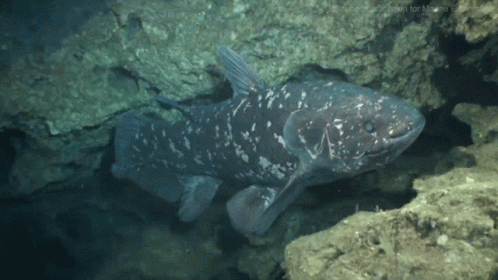
Below are her original sketch and desciption of the specimen she recovered from a South African fishing boat's catch and did her best to preserve until the ichthyologist she was writing to, J. L. B. Smith (South African, 1897 - 1968) could arrive to identify it. He was indeed able to confirm it was the long-lost Coelacanth, and give the genus the scientific name Latimeria in her honor.

Here is a four-stamp set issued by South Africa in 1989 commemorating the event, designed by Sheila Nowers:
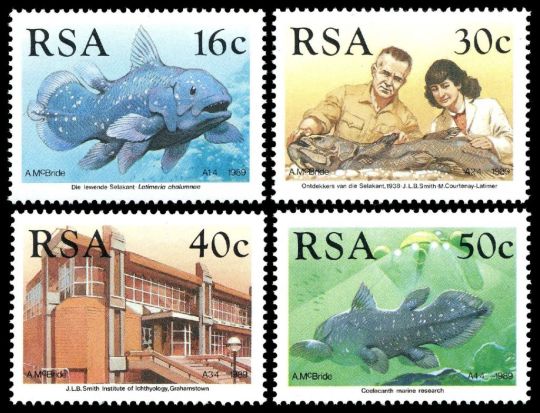
PS - the 1938 one is now known as the West Indian Ocean Coelacanth (Latimeria chalumnae), as there was a SECOND living species confirmed in 1999, named the Indonesian Coelacanth (L. menadoensis). Its find was commemorated by Indonesia with this 2000 souvenir stamp sheet:

Here is a cool video about this amazing "Lazarus taxon" and Marjorie Courtenay-Latimer's key role in finding and perserving her now-famous specimen for science:
Animated Life: The Living Fossil Fish | HHMI BioInteractive Video
youtube
#Marjorie Courtenay-Latimer#J. L. B. Smith#lazarus taxon#coelacanth#West Indian Ocean Coelacanth#African Coelacanth#Indonesian Coelacanth#Sulawesi Coelacanth#fish#ichthyology#history of science#drawing#sketch#letter#works on paper#20th century#1930s#stamps#postage stamps#philately#South Africa#Indonesia#OTD#birthday#animals in art#Youtube
82 notes
·
View notes
Video
youtube
the coelacanth is more closely related to humans than to other fish
17 notes
·
View notes
Text
I recently found out a show I liked is 10 years old now so to not be the oldest thing on this blog I'm talking coelacanths for Wet Beast Wednesday. Coelacanths are rare fish famed for being living fossils. While that term is highly misleading, it is true that coelacanths are among the only remaining lobe-fined fish and were thought to have gone extinct millions of years ago before being rediscovered in modern times.
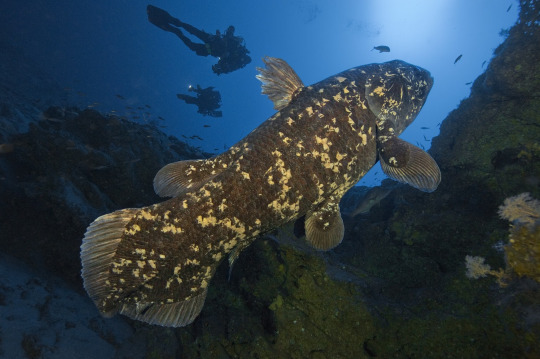
(image id: a wild coelacanth. It is a large, mostly grey fish with splotches of yellowish scales. Its fins are attached to fleshy lobes. It is seen from the side, facing the top right corner of the picture)
Coelacanth fossils had been known since the 1800s and they were believed to have gone extinct in the late Cretaceous period. That was until December 1938, when a museum curator named Marjorie Courtenay-Latimer was informed of an unusual specimen that had been pulled in by local fishermen. After being unable to identify the fish, she contacted a friend, ichthyologist J. L. B. Smith, who told her to preserve the specimen until he could examine it. Upon examining it early next year, he realized it was indeed a coelacanth, confirming that they had survived, undetected, for 66 million years. Note that fishermen living in coelacanth territory were already aware of the fish before they were formally described by science. Coelacanths are among the most famous examples of a lazarus taxon. This term, in the context of ecology and conservation, means a species or population that is believed to have gone extinct but is later discovered to still be alive. While coelacanths are among the oldest living lazarus taxa, they aren't the oldest. They are beaten out by a genus of fly (100 million years old) and a type of mollusk (over 300 million years old).

(image: a coelacanth fossil. It is a dark brown imprint of a coelacanth on white rock. Its skeleton is visible in the imprint)
Coelacanths are one of only two surviving groups of lobe-finned fish along with the lungfishes. Lobe-finned fish are bony fish notable for their fins being attached to muscular lobes. By contrast, ray-finned fish (AKA pretty much every fish you've ever heard of that isn't a shark) have their fins attached directly to the body. That may not sound like a big difference, but it actually is. The lobes of lobe-finned fish eventually evolved into the first vertebrate limbs. That makes lobe-finned fish the ancestors of all reptiles, amphibians, and mammals, including you. In fact, you are more closely related to a coelacanth than a coelacanth is to a tuna. Coelacanths were thought to be the closest living link to tetrapods, but genetic testing has shown that lungfish are actually closer to the ancestor of tetrapods.
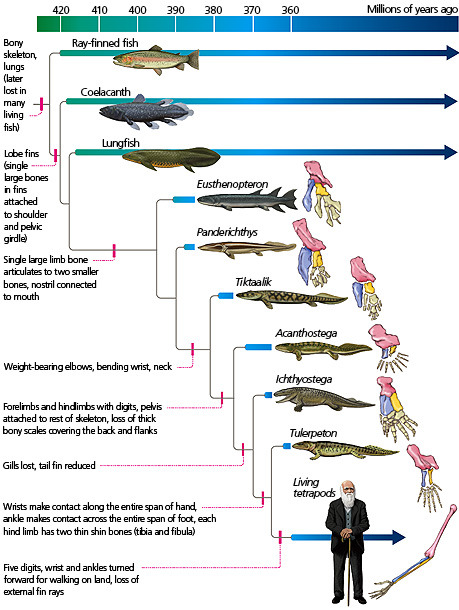
(image id: a scientific diagram depicting the taxonomic relationships of early lobe-finned fish showing their evolution to proto-tetrapods like Tiktaalik and Ichthyostega, to true tetrapods. Source)
There are two known living coelacanth species: the west Indian ocean coelacanth (Latimeria chalumnae) and the Indonesian coelacanth (L. menadoensis). Both are very large fish, capable of exceeding 2 m (6.6 ft) in length and 90 kg (200 lbs). Their wikipedia page describes them as "plump", which seems a little judgmental to me. Their tails are unique, consisting of two lobes above and below the end of the tail, which has its own fin. Their scales are very hard and thick, acting like armor. The mouth is small, but a hinge in its skull, not found in any other animal, allows the mouth to open extremely wide for its size. In addition, they lack a maxilla (upper jawbone), instead using specialized tissue in its place. They lack backbones, instead having an oil-filled notochord that serve the same function. The presence of a notochord is the key characteristic of being a chordate, but most vertebrates only have one in embryo, after which it is replaced by a backbone. Instead of a swim bladder, coelacanths have a vestigial lung filled with fatty tissue that serves the same purpose. In addition to the lung, another fatty organ also helps control buoyancy. The fatty organ is large enough that it forced the kidneys to move backwards and fuse into one organ. Coelacanths have tiny brains. Only about 15% of the skull cavity is filled by the brain, the rest is filled with fat.

(image id: a coalacanth. It is similar to the one on the above image, but this one is blue in color and the head is seen more clearly, showing an open mouth and large eye)
One of the reasons it took so long for coelacanths to be rediscovered is their habitat. They prefer to live in deeper waters in the twilight zone, between 150 and 250 meters deep. They are also nocturnal and spend the day either in underwater caves or swimming down into deeper water. They typically stay in deeper water or caves during the day as colder water keeps their metabolism low and conserves energy. While they do not appear to be social animals, coelacanths are tolerant of each other's presence and the caves they stay in may be packed to the brim during the day. Coelacanths are all about conserving energy even when looking for food. They are drift feeders, moving slowly with the currents and eating whatever they come across. Their diet primarily consists of fish and squid. Not much is known about how they catch their prey, but they are capable of rapid bursts of speed that may be used to catch prey and is definitely used to escape predators. They are believed to be capable of electroreception, which is likely used to locate prey and avoid obstacles. Coelacanths swim differently than other fish. They use their lobe fins like limbs to stabilize their movements as they drift. This means that while coelacanths are slow, they are very maneuverable. Some have even been seen swimming upside-down or with their heads pointed down.
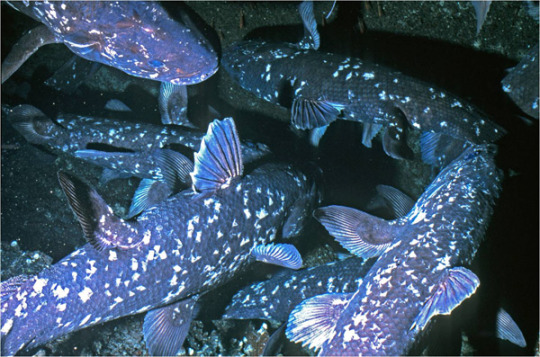
(image: an underwater cave wilt multiple coelacanths residing in it. 5 are clearly visible, with the fins of others showing from offscreen)
Coelacanths are a vary race example of bony fish that give live birth. They are ovoviviparous, meaning the egg is retained and hatches inside the mother. Gestation can take between 2 and 5 years (estimates differ) and multiple offspring are born at a time. It is possible that females may only mate with a single male at a time, though this is not confirmed. Coelacanths can live over 100 years and do not reach full maturity until age 55. This very slow reproduction and maturation rate likely contributes to the rarity of the fish.

(image: a juvenile coelacanth. Its body shape is the same as those of adults, but with proportionately larger fins. There are green laser beams shining on it. These are used by submersibles to calculate the size of animals and objects)
Coelacanths are often described as living fossils. This term refers to species that are still similar to their ancient ancestors. The term is losing favor amongst biologists due to how misleading it can be. The term os often understood to mean that modern species are exactly the same as ancient ones. This is not the case. Living coelacanth are now known to be different than those who existed during the Cretaceous, let alone the older fossil species. Living fossils often live in very stable environments that result in low selective pressure, but they are still evolving, just slower.
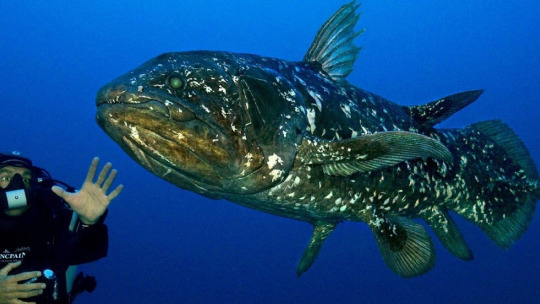
(image: a coelacanth swimming next to a SCUBA diver)
Because of the rarity of coelacanths, it's hard to figure out what conservation needs they have. The IUCN currently classifies the west Indian ocean coelacanth as critically endangered (with an estimated population of less than 500) and the Indonesian coelacanth as vulnerable. Their main threat is bycatch, when they are caught in nets intended for other species. They aren't fished commercially as their meat is very unappetizing, but getting caught in nets is still very dangerous and their slow reproduction and maturation means that it is long and difficult to replace population losses. There is an international organization, the Coelacanth Conservation Council, dedicated to coelacanth conservation and preservation.
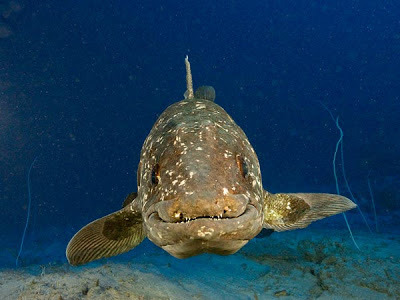
(image: a coelacanth facing the camera. The shape of its mouth makes it look as though it is smiling)
#wet beast wednesday#coelacanth#marine biology#biology#zoology#ecology#animal facts#fish#fishblr#old man fish#lobe-finned fish#sarcopterygii
1K notes
·
View notes
Text
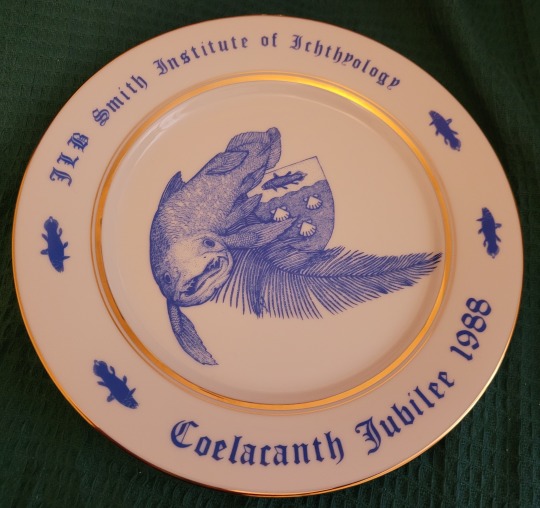
Today in coelacanth collecting!
I've just picked up this amazing full-sized plate created to commemorate the 50th anniversary of the discovery of the coelacanth!
It's from the JLB Smith Institute of Ichthyology, named after J.L.B. Smith, who was the ichthyologist that identified Marjorie Courtenay-Latimer's mysterious fish as a coelacanth. The JLB Smith Institute is now the South African Institute for Aquatic Biodiversity, and has the African Coelacanth Ecosystem Programme Marine Platform, a collection of equipment and boats to help scientists study coelacanths.
This is much bigger than my Wedgwood coelacanth plate, but since it was under £10 from eBay, I am not complaining.
Just look at that little face!
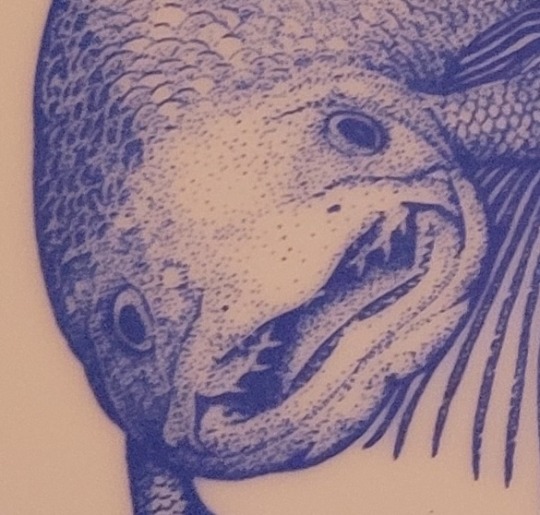
And is this a coelacanth coat of arms? Amazing!
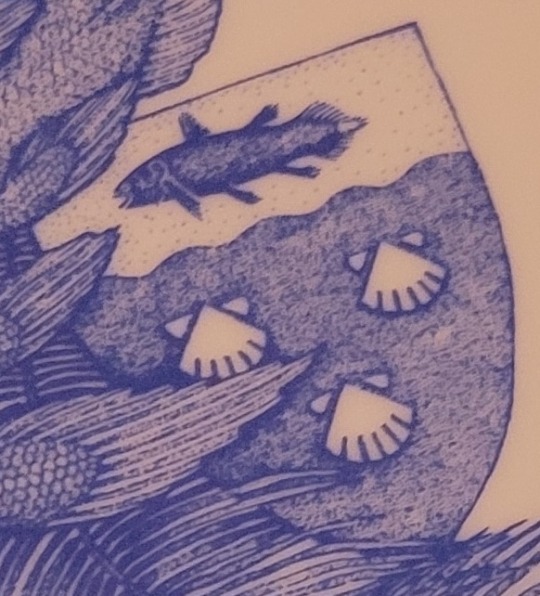
#coelacanth#coelacanth plate#coelacanth kitchenware#jlb smith institute of ichthyology#coelacanth jubilee#coelacanth collection
244 notes
·
View notes
Text
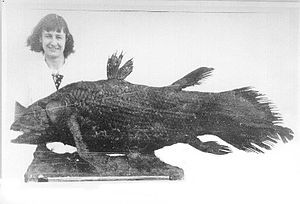
Fun fact: Marjorie Courtenay-Latimer, the woman who was instrumental in discovering the coelacanth, was a member of the International Society of Cryptozoology! She even wrote an article about it for its eighth issue.
157 notes
·
View notes
Text

🐟 IT'S COELACANTH DAY! 🐟
On December 23rd, 1938, an unusual fish was caught off the coast of South Africa near the mouth of the Chalumna river by Captain Henrik Goosen. Recognizing its potential significance, he showed it to his friend and local museum curator, Marjorie-Courtenay Latimer, who reluctantly had it taxidermied to preserve it long enough for her colleague J. L. B. Smith to identify, as he was unfortunately unavailable while the specimen was fresh and easier to study.
Nonetheless, Smith identified the animal as a modern-day descendant of coelacanths, a fish up to then only known through fossils over 66 million years old and presumed long extinct. Smith gave the animal the scientific name Latimeria chalumnae, in honor of his colleague's contribution to the historic discovery as well as the river they were found somewhat close to, I guess.

Thanks to the combined efforts of these amateur and professional naturalists, people all around the world can admire and protect these wonderful, bizarre, and unique animals. Now we can celebrate the re-birthday of the coelacanth every year on December 23rd!.
🐟Happy Coelacanth Day Everyone!🐟
119 notes
·
View notes
Photo
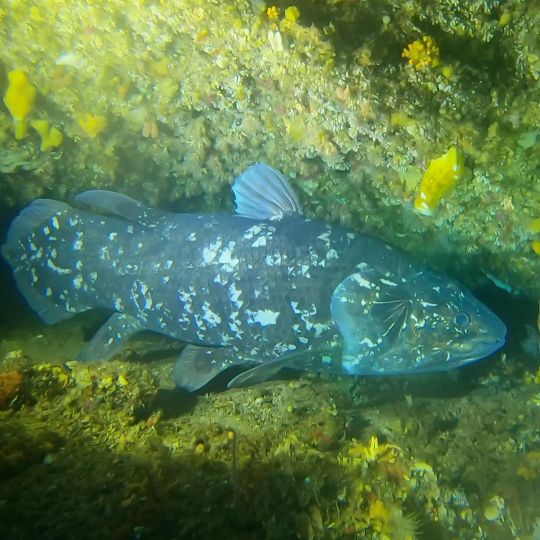
CoelaCANTh? More like coelaCAN! Scientists once thought that coelacanths went extinct some 70 million years ago during the Cretaceous. Then, one turned up in 1938 when a fisherman caught a living coelacanth off the coast of South Africa. Plot twist: Decade laters, another species of coelacanth was caught. Did you know? These ancient "fish" are actually more closely related to land animals. Their paired fins are lobelike and have joined bones, like arms and legs. Coelacanths live in deep saltwater environments and can grow up to 6 feet (2 m) long. They have an organ filled with a jelly-like substance located near the front of their heads, a trait found in no other vertebrate. Scientists think this “rostral organ” helps the coelacanth hunt, allowing it to detect low-frequency electrical signals emitted by prey. What’s more? Unlike most other fish, coelacanths give birth to live young—a fact that remained unknown until 1975, when the Museum’s first coelacanth specimen was dissected and found to be pregnant with five embryos. Photo 1: A living coelacanth (Latimeria chalumnae), wrecklessmarine, CC BY-NC 4.0, iNaturalist Photo 2: Marjorie Courtenay-Latimer, the curator of the East London Museum in South Africa, who discovered the 1938 coelacanth. Photo 3: From left to right: Ichthyology Curator James Atz, Dr. Charles Rand, Ichthyology Curator C. Lavett Smith, © AMNH Library (circa September 1975) #science #discovery #amazingnature #wildlife #amnh https://www.instagram.com/p/Cpk7X2DLeMj/?igshid=NGJjMDIxMWI=
469 notes
·
View notes
Text
This is a story about a book that changed my life.
It's also about how amazing libraries and authors and people who care about sharing cool things with curious kids are. Also, fish (especially fish). It's kind of different than what I usually post but it's been bouncing around in my head basically since I started this blog so here you go, I hope you like it. This is the reason I love coelacanths so much, and why I think everyone should know about how amazing they are.
When I was little, I loved going to the library. My little brother and I would pick out way too many books and the librarians always had to come over to override the 30 book limit at the checkout stand (they pretty much knew us on sight and were ready to override it as soon as we started heading over to check out). After we finished getting our library books, our mom also let us look through the free pile that was in the foyer on the way out. It was mostly old library books that the librarians just needed to clean out, but there were a lot of books that people brought when they cleaned out their personal collections too (especially teachers, and there were a bunch of books with old school library stamps inside). The free pile didn't usually have a lot of things that interested me, but one day when I was poking through it I found a book called Fossil Fish Found Alive: Discovering the Coelacanth, by Sally M. Walker.
I loved it. I had never even heard of coelacanths before, but this book fascinated me. It told the story of an incredible animal, long thought to be extinct, that had somehow survived for millions of years! It was nothing like any fish I had ever learned about before. I already had a casual interest in marine biology that I can thank PBS Kids and Wild Kratts for (particularly their episode on sperm whales and giant squid, I loved that episode), but this book took it to a new level. I wanted to be a marine biologist so I could learn more about coelacanths.
Like a lot of things when you're 7, that was a phase. Unlike a lot of phases, this one I came back to. After taking a break from my dreams of being a marine biologist to experience the hell that is middle school, one day I pulled a book off my shelf. I hadn't read it in a while. When I picked it up again, I remembered how incredible this animal was, and how much it had inspired me when I was younger, and those thoughts of becoming a marine biologist started to return. I'm in college now studying marine science, and I brought the book with me to school, where it sits next to two other science books that have inspired me (My Friends the Wild Chimpanzees by Jane Goodall and The Sea Around Us by Rachel Carson).
Earlier this year, I was thinking about how much this one book had changed my life and I wondered if I could find Ms. Walker and thank her. I knew she had many other science books for younger audiences, and even another book about coelacanths, so I was sure she had a website of some kind, and I was right. So I found her contact page and wrote her an email explaining the impact her book had had on my life, and thanking her for it. And to my surprise, she responded! She was very kind and we sent a few emails back and forth. She gave me some excellent advice and even told me about some of the people she contacted while researching her book, including Marjorie Courtenay-Latimer herself, the person who rediscovered the coelacanth when it was thought to be extinct! I'll never forget how she took the time to respond to me and how encouraging she was.
But Ms. Walker isn't the only one I have to thank for pointing me toward the path I'm on right now. If I hadn't already loved reading, if I hadn't seen any show or video to make me interested in marine biology, if the library didn't have a pile of books for anyone to take home, if I had lost that book during one of our many moves as a kid, I don't know what I'd be doing right now. There were a lot of things that happened to make it so that I found this book, but I'm glad for every single one of them. They led to me learning about an incredible animal and changed the course of my life. And now, I love coelacanths.
#long post#bee talks#my post#coelacanth#i love coelacanths#omg guys its the long awaited ilovecoelacanths backstory post#it came out kinda sappy lmao but whatever im gonna post it even though its so cheesy#ugh i hate being genuine and showing emotion on the internet it makes me feel so cringe. but whatever. cringe is dead so#also wow look at that i actually CAN use real grammar when i want to#not a single smiley face emoticon in this whole post. why did i do that. i like my little guys#here. here's one. :]
108 notes
·
View notes
Photo
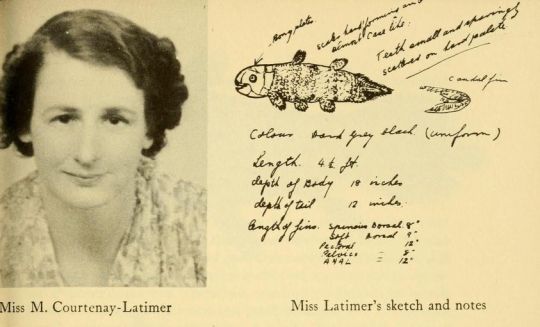
Curator of the Natural History museum in East London, South Africa, Marjorie Courtenay-Latimer was the first person to discover (in a meaningful way) that the coelacanth wasn’t extinct, but was simply the vile-tasting “gombessa” that had been thrown away for decades.
32 notes
·
View notes
Link
TIL Discoverer of coelacanth, Marjorie Courtenay-Latimer, faced many obstacles.
0 notes
Photo


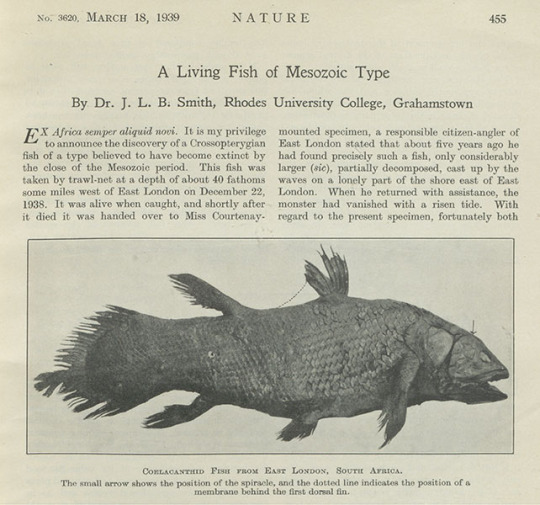
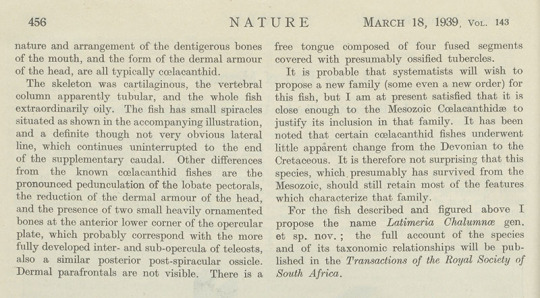
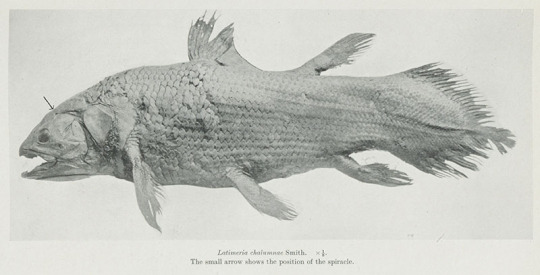
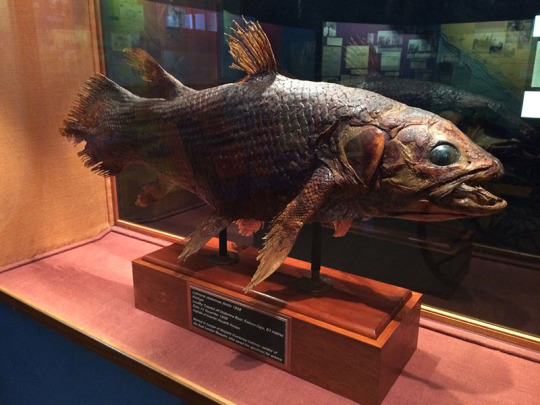
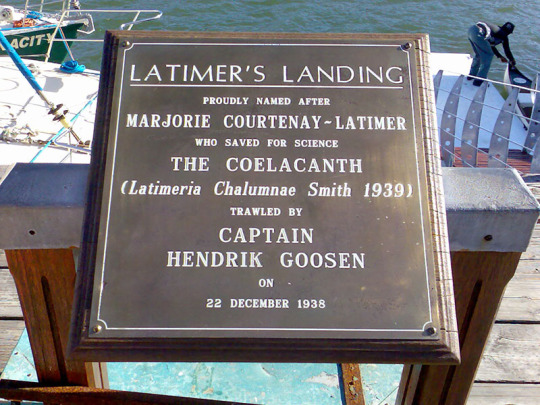

Marjorie Courtenay-Latimer – Scientist of the Day
Marjorie Courtenay-Latimer, a South African naturalist and museum curator, was born Feb. 24, 1907.
read more...
#Marjorie Courtenay-Latimer#J.L.B Smith#coelacanth#ichthyology#South Africa#histsci#histSTM#20th century#history of science#Ashworth#Scientist of the Day
51 notes
·
View notes
Note
What are coelecanths for those of us who dont know and find it way more entertaing to ask a tumblr blog instead of googling it? Sorry if youve done this one already (you probably have)
OH SNAP TIME FOR AN INFODUMP
Coelacanths are a species of fish that live in two places: the West Indian Ocean, especially along South Africa, and Indonesia. And they live deep down in the water, but not deep enough, so trawler fishermen occasionally snag one.
And that's how we found out they existed, because a fisherman picked one up, and was like "goddamn this is a weird looking fish" and called up his museum curator buddy Marjorie Courtenay-Latimer. She was like "omg weird fish, I love it" and started trying to figure out what branch of fish it was from and that...
That's when it gets funky.
Because, see, these fish, they are OLD. They are OLD AS BALLS.
Not individually (although they could be, there are some debates on that), but evolutionarily. Like, we can trace human ancestors back pretty far, and we know where all our recent ones were and they're not that old.
A coelacanth? Its last ancestor was over 150 million years ago. As far as the fossil record goes, it has not evolved since then.
When Marjorie looked at the sample her fisherman buddy gave her, she was like "dude. This fish is a FOSSIL. I have only seen fish like this IN ROCKS."
Coelacanths spend so much time down in dark deep cold water that they just haven't bothered to evolve. They're like "we're good here, this is awesome, hey check it out, a cuttlefish, that's good eating."
And that's why they're so fucking cool. This ancient-ass fish have just been chilling out for literal millennia, letting the world pass them by, not evolving, just perfectly happy where they are. And now we get to see them and be like "y'all rock."
741 notes
·
View notes
Text
Coelacanths, “The Living Fossil”
youtube
youtube
The Ancestor’s Tale, Rendezvous 19: Coelacanths
Coelacanths were believed to have been extinct since even before the dinosaurs until a living one was discovered 22 December 1938. From seeing a sketch of the fish by Marjorie Courtenay-Latimer, Dr. J.L.B. Smith said “I would not have been more suprised if I had seen a dinosaur walking down the street.” There are only two species of Coelacanths in this scarce genus.
#The Ancestor's Tale#Rendezvous 19#Coelacanths#Marjorie Courtenay-Latimer#Dr. J.L.B. Smith#JLB smith#Richard Dawkins
0 notes
Text
It’s time for some facts about coelacanths!
I said I’d do this a while ago and I forgot so I’m doing it now because coelacanths are the best and more people should know how cool they are! I did not mean for this post to turn out so long but I promise the facts are very good (how could they not be when coelacanths are so cool)
There are two living species of coelacanth, Latimeria chalumnae, the West Indian Ocean coelacanth, and Latimeria menadoensis, the Indonesian coelacanth.
This is a West Indian Ocean coelacanth, they’re dark blue and each one has a unique pattern of white spots:
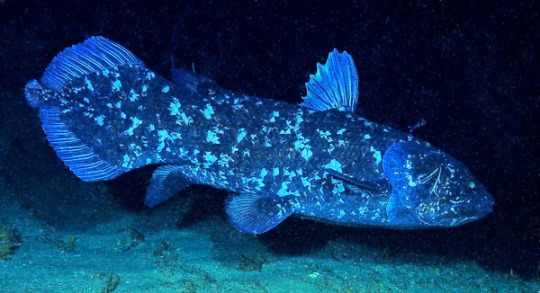
And this is an Indonesian coelacanth:
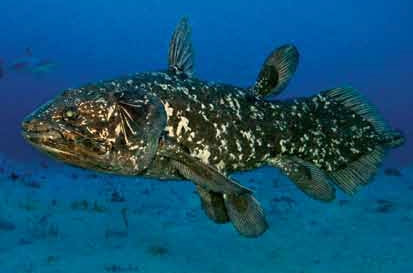
Indonesian coelacanths are noticeably different from West Indian Ocean coelacanths due to their background colouration being more of a greyish brown rather than blue. Their spots also appear more gold due to light reflecting off them :)

Coelacanths are old! The oldest coelacanth fossils date to more than 400 million years ago, and they were thought to have gone extinct about 66 million years ago, until 1938 when one was accidentally caught off the coast of South Africa and found by Marjorie Courtenay-Latimer.
Latimer contacted her friend, the ichthyologist J. L. B. Smith, who confirmed the fish was a coelacanth! Smith was given the honor of naming the fish, and he named it Latimeria after Marjorie Courtenay-Latimer. (Shown below with the coelacanth she found)
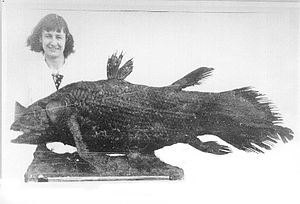
After their discovery, people mistakenly described them as the 'missing link' thanks to their leg-like fins, and this myth persisted thanks to the interesting way coelacanths swim, which appears almost like crawling.
Even today they are sometimes called 'living fossils' because of how little they have changed over millions of years. This label is not technically accurate since they are still evolving, but they do have one of the slowest evolving genomes in the animal kingdom, probably because they're already very well adapted to their environment and they don't have a lot of selection pressures affecting them.
Coelacanths can be more than six feet (up to two meters) long, weigh up to 200 pounds, and are estimated to be able to live up to 100 years! They are covered in hard, armor-like rough scales that are themselves covered in tiny spikes called denticles, which help protect coelacanths from rocks and other fish that might want to hurt them.
They also give birth to live young in litters of 10-25 pups and new research suggests they can be pregnant for as long as 5 years! This would mean that they beat out the frilled shark as the record holder for the longest gestation period by more than a year!
(Unfortunately this means that the birth rate for coelacanths is very low, which doesn't help their small populations. The West Indian Ocean coelacanth is critically endangered, and the Indonesian coelacanth is classified as threatened :( )
Coelacanths are what’s called a lobe-finned fish! This means that their fins look more like stumpy appendages than skin that's been stretched over flexible spines. Their closest relatives are lungfish, and that actually means they’re more closely related to us humans than they are to ray-finned fish like tuna or goldfish! Hell yeah!
Coelacanths live in the "twilight zone" which is between 500-800 feet deep. It’s hard to study coelacanths in their natural habitat for extended periods, but they never survive trips to the surface due to the pressure change, so a lot about their behavior is still pretty unknown.
Coelacanths are generally slow moving, nocturnal drift hunters, which means they tend to sort of just eat whatever fish cross their path, but they have a lot of interesting adaptations that make their particular method of drift hunting unique.
First, coelacanths have a hinge in their skull, called an intracranial joint, that lets them open their mouth more than would be possible with just their jaw.
Second, they display an interesting behavior when feeding, where they will float with their head pointed down, almost like they're doing a headstand. They do this while floating along catching prey, and it seems to be working out for them.
Third, coelacanths have a sixth sense! They have an organ in their snout called a rostral organ that functions as an electrosensor to help locate their prey by detecting the electrical signals given off by other animals!
They truly are a unique animal. They even have a caudal (tail) fin with three lobes instead of the two-lobed tail that is common in many fish.
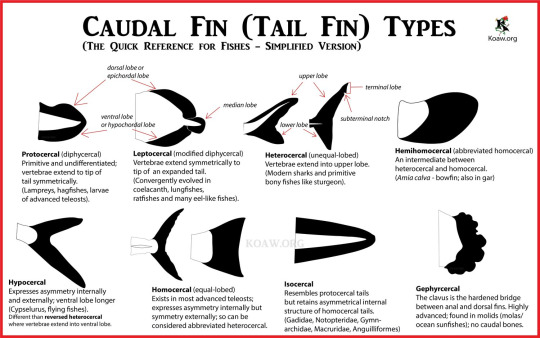
(source for this diagram)
And here you can see the three-lobed caudal fin on a real coelacanth (and also you can have a reminder of how big these guys are. They are not little fish)
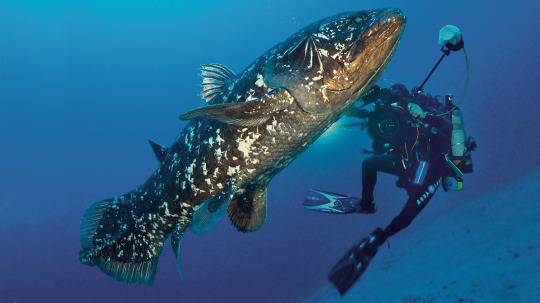
It seems coelacanths also have more similarities to their relatives, the lungfish, than we used to think. It turns out coelacanths have a vestigial lung! They have a lung that they don’t use anymore! It’s all shrivelled and wrinkly but it’s there!
They also have a spiral shaped intestine! Some sharks have this too, it’s basically shaped like a spiral to increase surface area for maximum nutrient absorption.
Another way they differ from many other fish is their swim bladder, which is how they control their buoyancy! In most fish the swim bladder is filled with gas, but coelacanths' swim bladders are filled with oil and fat instead!
Coelacanths are also the proud owners of notochords! They don’t have backbones, they’re so old they were around before animals had backbones and they just never got one, they still have their oil filled notochords! Don't fix it if it's not broken, right?
Also, just in case you were wondering, they would not taste good, they are full of all sorts of oils (as mentioned in the above two facts), plus they do have very hard and rough scales. (But also even if they did taste good it would be a bad idea to eat them since there aren't a lot of them left and it's generally considered bad to eat endangered species)
Well, that's the end of my coelacanth facts, so if you took the time to read this whole long post that was just me talking about my favorite animal, thanks for sticking around! Here, have some bonus content!
Coelacanths make a guest appearance in Atlantis: the Lost Empire!

I like seeing them in the movie so I ignore they weren’t discovered when the film takes place in 1914 (easy to ignore) and that they wouldn’t survive the trip to the surface due to the immense pressure change (less easy to ignore but I do it anyway) :)
My friend @thelunarbee even crocheted me one for a Christmas present :’) his name is Milo and I love him so so much
I also drew a coelacanth a while ago, here's where I posted it if you want to see it :) (I mean, I draw coelacanths all the time but those are mostly doodles, this one I actually put effort into)
Alright that's all I have to say, but I hope you liked the coelacanth facts and remember, if coelacanths can survive for 400 million years, you can make it through today. Be kind to yourself :)
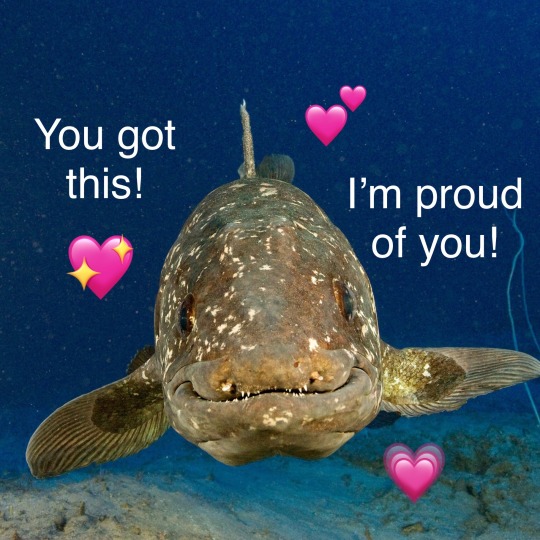
#coelacanth#i love coelacanths#sorry for the long post#me rambling#featuring the coelacanth aka my very favorite animal#this turned out way longer than i meant it to lol#fish#fish facts#coelacanth facts#im also a big fan of relicanth the coelacanth pokemon#i dont know anything about pokemon but i love bulbasaur and relicanth#i also want to play animal crossing very badly because i know there are coelacanths in it#basically if a piece of media has coelacanths its a guarantee that i'll want to consume it#also i love reading tags so if you have any thoughts feel free to tag this post#credit for that last coelacanth pic with all the hearts: me! I did that :)
521 notes
·
View notes
Text
The coelacanth can live for a century. This is not great news
The coelacanth can live for a century. This is not great news
https://theministerofcapitalism.com/blog/the-coelacanth-can-live-for-a-century-this-is-not-great-news/
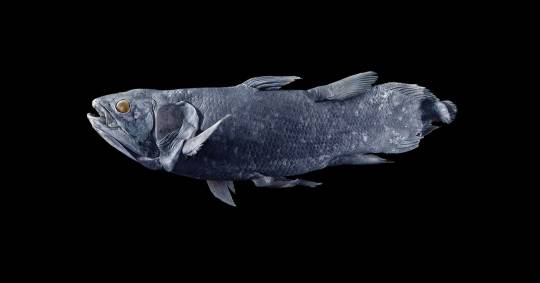
African coelacanths are very old. Fossil evidence dates to its genesis about 400 million years ago, and scientists thought they were extinct until 1938, when the museum’s curator Marjorie Courtenay-Latimer I noticed one live on a fishing net.
It is located on the southeast coast of Africa, coelacanths they also live a long time: scientists suspect it about 50 years. But to prove that life has been hard. (Coelacanths are endangered and accustomed to deep water, so scientists can’t put their babies in a tank and start a timer.) Now, a French research team examining their scales with polarized light has determined that they can probably live much, much longer. . “We were surprised,” says Bruno Ernande, a marine ecologist who led the study. The new beloved life, he says, “was almost a century old.”
His team from the French Institute for the Exploitation of the Sea, or IFREMER, found not only that people can live up to about 100, but also that they have gestation periods of at least five years and that they may not mature sexually until they are at least 40. The results were published Thursday in Current biology. This slow-motion life highlights the importance of conservation efforts for this rare species, which is branded as “critically endangered.” IUCN Red List. There are only about 1,000 in the wild, and their long gestation and late maturity are bad news for the resistance of their population to human encounters. “It’s even more endangered than we thought before,” Ernande says.
“It will have huge consequences,” agrees Daniel Pauly, an ichthyologist at the University of British Columbia who did not participate in the study. Pauly is the creator of FishBase, a database of biological and ecological information on tens of thousands of species. If a fish takes decades to generate, killing it eliminates its potential to replenish the population. “A fish that needs 50 years to reach maturity, compared to 10 years, is five times more likely to have problems,” he says.
Coelacanths are thick scales that grow up to two inches long, and for decades ichthyologists have debated how to read these scales for signs of age. In the 1970s, researchers noticed small calcified structures. They thought the rings were age markers, like tree rings. They did not agree, however, on how to count them: some thought that each marking indicated a year; others believed that seasonal flips created two rings a year. At the time, the best conjecture placed life expectancy at about 22 years. That conclusion, which meant a 6-foot, 200-pound coelacanth was 17 years old, meant they grew very fast: “They would grow as fast as tuna, which is crazy,” Pauly says.
It’s crazy because these are animals with slow metabolisms, which should indicate slow growth. The hemoglobin of coelacanths adapts to this slow metabolism, meaning they cannot take in enough oxygen to support a fast-growing fish. Some argue that their small gills are another test of oxygen limitations. They also live very passive lifestyles, resting most of the day in caves and slowly traversing neighborhoods. twilight zone of the ocean, down to 650 feet and below, when they deign to move. “Overwhelmingly, the biological characteristics pointed to a slow-moving fish,” Ernande says.
In addition, scientists who track the lives of individual coelacanths have learned that 20 years is too low. In the eighties, researchers He began sending submersible and remote-controlled vehicles to a cave containing between 300 and 400 coelacanths. They returned to this place for over 20 years. During each visit, individuals were recognized for their characteristic white marks. Only about three or four fish in this group died and an equal number would be born each year. This observation provided startling evidence that coelacanths live long lives, even over 100 years, argues this study.
Source link
0 notes
Quote
TIL Discoverer of coelacanth, Marjorie Courtenay-Latimer, faced many obstacles.
0 notes